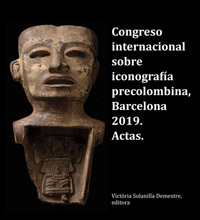Zea E-Books

Congreso internacional sobre iconografía precolombina, Barcelona, 2019. Actas.
Date of this Version
7-20-2020
Document Type
Article
Citation
Publicado en Congreso internacional sobre iconografía precolombina, Barcelona 2019. Actas, Victòria Solanilla Demestre, editora (Lincoln, Nebraska: Zea Books, 2020).
Abstract
Las figurillas del periodo Formativo (2300 a.C.-100 d.C.), de la Cuenca de México, modeladas en barro, antropomorfas y sólidas, se distinguen por ser representaciones realistas, y al parecer, algunas de ellas son versiones a escala que muestran personajes, es decir, son pequeñas esculturas inspiradas en algunos miembros de la comunidad que se destacan por sus atributos o parafernalia. Estos atributos son indicadores de un claro reconocimiento de diferenciación social, asociados con personajes que desempeñaban roles específicos dentro de la sociedad y que, al parecer, son recreaciones de jugadores de pelota.
Figurines from the Formative period (2300 b.C.-100 a.C.) in the Mexican Basin, modeled out of clay, solid and anthropomorphic are distinguished for being realistic representations, and it seems like some of them are scale versions that recreate characters, which means that they are small sculptures inspired in some members of the community which stand out with differentiating attributes or paraphernalia. These attributes indicate clear social difference recognition, associated with characters which had specific roles inside the society and that seem to be ballplayer representations.
Included in
American Material Culture Commons, Indigenous Studies Commons, Museum Studies Commons, Other History of Art, Architecture, and Archaeology Commons, Other Languages, Societies, and Cultures Commons


Comments
Copyright 2020 por la autora.